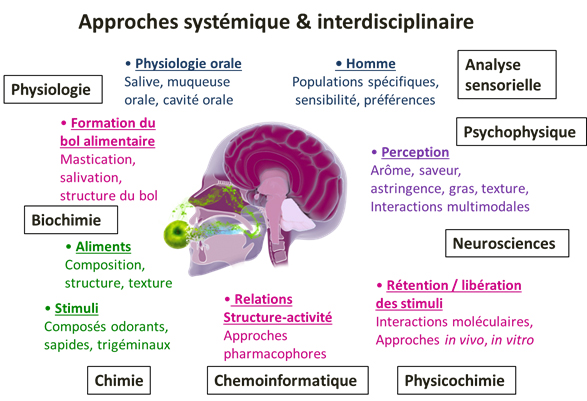
Responsable d'équipe
Thierry Thomas-Danguin
Téléphone : 03 80 69 30 84
Email : thierry.thomas-danguin@inrae.fr


Responsable d'équipe
Téléphone : 03 80 69 30 84
Email : thierry.thomas-danguin@inrae.fr

chercheurs
G. Feron, H. Labouré, A. Lavoisier, Y. Le Fur, E. Neyraud, J. Piornos Martínez, M. Schwartz, C. Sinding, R. Srivastava.
IngÉnieurs et techniciens
H. Brignot, C. Follot, Z. Hernandez, B. Houinsou Houssou, M. Lelievre, F. Ménétrier, J. Moreno, V. Senty-Ségault, C. Septier.
doctorants
L. Debraine, L. Joubert-Laurencin, G. Le Guillas, A. Proskura.
Post-doctorants
A. Godet.
stagiaires
E. Delacroix, C. Girard.
Mots-clés : Flaveur, libération, aliment, salive, interactions perceptives, structure moléculaire, biochimie, physiologie, mécanismes cérébraux.
Thématique : Les travaux de l’équipe ont pour principal objectif de comprendre les mécanismes conduisant à la libération des molécules de la flaveur et leur impact sur la perception sensorielle globale chez l’homme.
L'équipe en détail Ouvrir tous les onglets
Les travaux de l’équipe ont pour but d’explorer les mécanismes à l’origine de la formation de la représentation mentale des aliments chez l’homme, prenant en compte la composition et la structure de l’aliment, la formation du bol alimentaire, la physiologie orale, les interactions moléculaires impliquant les molécules de la flaveur en bouche et les interactions multimodales intervenant au niveau du système nerveux central.

Thème 1 : Propriétés sensorielles des stimuli de la flaveur seuls et en mélange (molécules odorantes, sapides, à effet trigéminal), interactions multimodales
Thème 2 : Mécanismes de rétention / libération des stimuli de la flaveur (arôme, saveur) et de leur perception en fonction de l’aliment et de l’individu
Thème 3 : Interactions moléculaires avec la matrice et les cibles biologiques
Thème 4 : Modulation des paramètres de physiologie orale (stimulations, âge, environnement)
European Project TeRiFiQ (2012 – 2015) : Combining Technologies to achieve significant binary Reductions in sodium, Fat and Sugar content in everyday foods whilst optimising their nutritional Quality.
Projet Européen SALAMANDER (2017 – 2020) : SALivAry bioMarkers of mediterraneAN Diet associated with long-tERm protection against type 2 diabetes mellitus.
ANR AlimaSSens (2015-2018) : vers une offre Alimentaire Adaptée et Saine à destination des populations SeniorS.
ANR Muffin (2015-2017) : MUcosal salivary Film & Flavor Interactions.
FUI Rémus (2014-2017) : Remusclons nos séniors.
FUI Octave (2015-2019) : Nouveaux obturateurs et expertises à haute valeur ajoutée pour un meilleur vieillissement des vins blancs.
IC-Qualiment PATATE (2015-2018) : Physiologie orale et Acceptabilité de la Texture de l'AlimenT chez le jeune Enfant.
IC-QUaliment QualigrasPhy (2013-2016) : Déterminants de la variabilité interindividuelle de la perception du gras chez l’homme.
Fondation Agropolis : Chaman (2015-2018) : Prédire le potentiel organoleptique « chocolat » d’un échantillon de cacao.
IC-Qualiment NutriSensAl (2017-2019) : Outil d’aide à la reformulation d’aliments nutritionnellement et sensoriellement bons et répondant aux exigences environnementales.
Laffon, E., Hummel, T., Marthan, R. and Sinding, C. (2020). Modelling analysis of centroid curves of olfactory habituation in humans. Physiol. Behav. 214: 112751.
Voir la publicationBrignot, H. and Feron, G. (2019). Oral lipolysis and its association with diet and the perception and digestion of lipids: A systematic literature review. Arch. Oral Biol. 108: 104550.
Voir la publicationDeuscher, Z., Andriot, I., Sémon, E., Repoux, M., Preys, S., Roger, J.-M., Boulanger, R., Labouré, H. and Le Quéré, J.-L. (2019). Volatile compounds profiling by using Proton Transfer Reaction - Time of Flight - Mass Spectrometry (PTR-ToF-MS). The case study of dark chocolates organoleptic differences. J. Mass Spectrom. 54(1): 92-119.
Voir la publicationGuichard, E., Barba, C., Thomas-Danguin, T. and Tromelin, A. (2019). Multivariate statistical analysis and odour-taste network to reveal odour-taste associations. J. Agric. Food Chem. in press: 10.1021/acs.jafc.1029b05462.
Voir la publicationPénicaud, C., Ibanescu, L., Allard, T., Fonseca, F., Dervaux, S., Perret, B., Guillemin, H., Buchin, S., Salles, C., Dibie, J. and Guichard, E. (2019). Relating transformation process, eco-design, composition and sensory quality in cheeses using PO2 ontology. Int. Dairy J. 92: 1-10.
Voir la publicationRobert-Hazotte, A., Schoumacker, R., Semon, E., Briand, L., Guichard, E., Le Quéré, J.-L., Faure, P. and Heydel, J.-M. (2019). Ex vivo real-time monitoring of volatile metabolites resulting from nasal odorant metabolism. Sci. Rep. 9(1): 2492.
Voir la publicationTarrega, A., Yven, C., Semon, E., Mielle, P. and Salles, C. (2019). Effect of oral physiology parameters on in-mouth aroma compound release using lipoprotein matrices: An in vitro approach. Foods 8(3): E106.
Voir la publicationThomas-Danguin, T., Guichard, E. and Salles, C. (2019). Cross-modal interaction as a strategy to enhance salty taste and to maintain liking of low-salt food: a review. Food Funct. 10(9): 5269-5281.
Voir la publicationTournier, C., Demonteil, L., Canon, F., Marduel, A., Feron, G. and Nicklaus, S. (2019). A new masticatory performance assessment method for infants: a feasibility study. J. Texture Stud. 50(3): 237-247.
Voir la publicationVillière, A., Symoneaux, R., Roche, A., Eslami, A., Perrot, N., Le Fur, Y., Prost, C., Courcoux, P., Vigneau, E., Thomas-Danguin, T. and Guerin, L. (2019). Comprehensive sensory and chemical data on the flavor of 16 red wines from two varieties: Sensory descriptive analysis, HS-SPME-GC-MS volatile compounds quantitative analysis, and odor-active compounds identification by HS-SPME-GC-MS-O. Data brief 24: 103725.
Voir la publicationFeng, Y., Licandro, H., Martin, C., Septier, C., Zhao, M., Neyraud, E. and Morzel, M. (2018). The associations between biochemical and microbiological variables and taste differ in whole saliva and in the film lining the Tongue. Biomed Res. Int. 2018: 1-10.
Voir la publicationMuñoz-González, C., Feron, G., Brulé, M. and Canon, F. (2018). Understanding the release and metabolism of aroma compounds using micro-volume saliva samples by ex vivo approaches. Food Chem. 240: 275-285.
Voir la publicationPloyon, S., Morzel, M., Belloir, C., Bonnotte, A., Bourillot, E., Briand, L., Lesniewska, E., Lherminier, J., Aybeke, E. and Canon, F. (2018). Mechanisms of astringency: Structural alteration of the oral mucosal pellicle by dietary tannins and protective effect of bPRPs. Food Chem. 253: 79-87.
Voir la publicationRomagny, S., Coureaud, G. and Thomas-Danguin, T. (2018). Key odorants or key associations? Insights into elemental and configural odour processing. Flavour Frag. J. 33(1): 97-105.
Voir la publicationSchwartz, C., Madrelle, J., Brignot, H., Delarue, J., Cuvelier, G., Nicklaus, S., Feron, G. and Tournier, C. (2018). Acceptance of added fat to first complementary feeding purees: An exploration of fat type, feeding history and saliva composition Appetite 131: 160-168.
Voir la publicationSémon, E., Arvisenet, G., Guichard, E. and Le Quéré, J.-L. (2018). Modified proton transfer reaction mass spectrometry (PTR-MS) operating conditions for in vitro and in vivo analysis of wine aroma. J. Mass Spectrom. 53(1): 65-77.
Voir la publicationTromelin, A., Chabanet, C., Audouze, K., Koensgen, F. and Guichard, E. (2018). Multivariate statistical analysis of a large odorants database aimed at revealing similarities and links between odorants and odors. Flavour Fragr. J. 33(1): 106-126.
Voir la publicationVandenberghe-Descamps, M., Labouré, H., Septier, C., Feron, G. and Sulmont-Rossé, C. (2018). Oral comfort: a new concept to understand elderly people's expectations in terms of food sensory characteristics. Food. Qual. Prefer. 70: 57-67.
Voir la publicationBlanquet, J., Le Fur, Y. and Ballester, J. (2017). Computerized delimitation of odorant areas in gas-chromatography-olfactometry by kernel density estimation: Data processing on French white wines. Chemometrics Intell. Lab. Syst. syst. 167: 29-35.
Voir la publication






offres emplois - stages - thèses
Post-doctorate position in Neuroscience of flavor perception
For any further inquiries on the position, contact Charlotte Sinding
More informations...